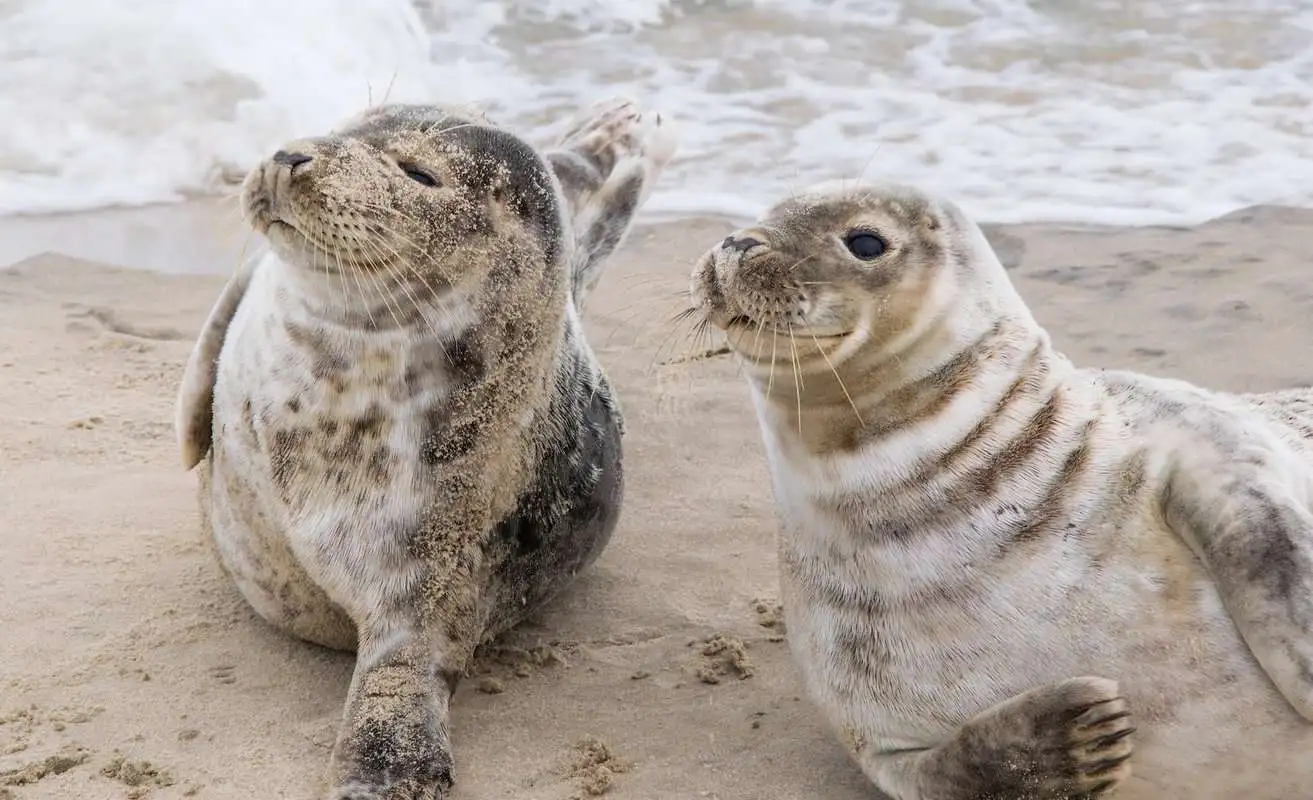Unveiling the Secrets of Seal Chatter: Dive into the incredible world of seal communication, where these clever marine mammals have mastered a complex language beyond our wildest imaginations. Get ready to witness the captivating vocalizations, expressive gestures, and chemical signals they use to chat, navigate their watery homes, and form tight-knit social bonds.
How Do Seals Communicate?
Ever wondered what those adorable, whiskered creatures are “saying” to each other? While seals might not speak our language, they possess their own fascinating ways of getting the message across! Let’s plunge into the world of seal communication and explore how they utilize sounds, body language, and even smells to converse beneath the waves.
A Symphony of Sounds: It’s All About the Vocals
Just like us, seals are a chatty bunch! They possess a diverse repertoire of sounds—barks, growls, whistles, and more—to communicate. Think of it as their version of a lively conversation.
These sounds aren’t random; they serve important purposes:
- Identification: Each seal has a unique voice, akin to a fingerprint, allowing them to recognize each other even in crowded colonies.
- Food Location: Seals are team players when it comes to finding a meal. Vocalizations help them inform their companions about the whereabouts of the best fish.
- Predator Warnings: Alarm calls alert others to potential threats, such as sharks or other predators.
- Mate Attraction: During mating season, males use their voices to attract females and boast about their strength and worthiness.
Beyond the Barks: Body Language Speaks Volumes
Imagine conversing without uttering a single word—that’s what seals do! They’ve become masters of body language, utilizing postures, movements, and gestures to convey their messages.
- Dominance and Territory: A resounding tail slap on the water is a clear signal of dominance or a warning to rivals to back off.
- Submission and Greetings: A gentle head bob can indicate submission or serve as a relaxed greeting.
- Play and Aggression: Flipper movements are incredibly expressive, used to display aggression, invite play, or signal friendliness.
Secret Scents: Chemical Communication
Seals possess a secret weapon in their communication arsenal—their sense of smell. They release unique scents through glands on their bodies, like a personal perfume. These scents, while undetectable to us, carry vital information for seals:
- Kin Recognition: Chemical signals help seals identify their relatives and avoid accidental fraternization with distant kin.
- Territory Marking: Seals utilize scent to mark their territory, informing others that the prime spot is already claimed.
- Bond Strengthening: Specific scents, particularly between mothers and pups, strengthen bonds within seal communities.
How Do Seals Communicate – Unraveling the Mysteries of Underwater Vocalizations
Harbor seals, renowned for their chattiness, utilize a combination of sounds, body language, and scents to communicate effectively underwater. Their vocalizations, in particular, are a testament to their complex communication system.
Imagine harbor seals possessing their own underwater language, replete with “words” and “phrases” composed of various sounds. Among their favorites is a powerful roar peaking at a frequency of 1.2 kHz. This underwater shout serves as both a warning to potential threats— “Hey, back off, I’m bigger than you!”—and a means of establishing dominance within the seal hierarchy.
Their vocal repertoire extends beyond roars to encompass a variety of underwater sounds, including tonal honks, grunts, growls, moans, and specialized calls specifically for mother-pup communication.
Interestingly, when harbor seals surface for air, their communication style shifts. Above water, they switch to barks, snores, hisses, and even sneezes! These airborne sounds play a crucial role in maintaining order within the group and signaling danger.
Seal pups, those adorable little ones, also possess their unique way of communicating. Their calls, significantly higher-pitched and more frequent than those of adults, resemble a baby’s cry. These calls help mothers locate their pups in crowded environments and strengthen the bond between them.
Here’s a table summarizing their fascinating array of sounds:
| Location | Sound Type | Purpose |
|---|---|---|
| Underwater | Roars | Predator warnings, dominance displays |
| Underwater | Honks, Grunts, etc. | Group cohesion, general communication |
| Underwater | Pup Contact Calls | Mother-pup bonding |
| Above Water | Barks | Threat displays, contact calls |
| Above Water | Snores, Hisses | Threat displays, maintaining group dynamics |
While we’ve made significant strides in understanding seal communication, much remains to be discovered. For instance, scientists are intrigued by the possibility of seals using sound for underwater navigation and foraging, similar to a built-in sonar system. Additionally, the increasing levels of human-generated noise pollution raise concerns about its potential impact on seals’ ability to communicate effectively. Continued research into these captivating creatures promises deeper insights into their underwater world and informs conservation efforts to protect them for generations to come.
Types of Seal Sounds: From Barks and Whistles to Groans and Chugs
Picture strolling along a beach, greeted by a chorus of barks, whistles, and groans. Contrary to what one might assume, this isn’t a dog park—it’s a colony of seals! These remarkable creatures possess a surprisingly diverse vocabulary, utilizing a range of sounds to communicate. Let’s delve into the world of seal sounds and decipher their meanings.
Barks and Whistles: Keeping in Touch and Standing Out
Much like dogs bark for attention, seals bark to announce their presence, especially between mothers and their pups. However, barks aren’t always friendly; a sharp bark can also serve as a warning signal, alerting others to potential danger.
Whistles, on the other hand, possess a more nuanced meaning. Consider them the seal equivalent of a love song or a boastful display. Male seals often employ whistles to attract mates, showcasing their charm and fitness. Whistles can also be used to establish dominance within a group, akin to proclaiming, “Back off, this is my turf!”
Groans and Chugs: Expressing Emotions and Social Cues
We’ve all experienced the frustration of letting out a groan. Seals groan too, although their reasons might differ from our everyday woes. A low groan from a seal frequently signals aggression or a warning to steer clear of their territory. It’s their way of asserting, “Don’t mess with me!”
Chugs, conversely, are all about maintaining the peace. These low-pitched sounds often convey submission within a group, a way of acknowledging the dominant individual and avoiding conflict.
Yelps and Clicks: Signals of Distress and Navigation
Similar to a dog’s yelp, a seal’s yelp is a clear indication that something is amiss. This sharp, short sound expresses pain, fear, or distress, leaving no doubt that something is bothering them.
Finally, we have clicks, perhaps the most intriguing sound in a seal’s repertoire. These rapid, high-pitched sounds are believed to be used for echolocation, much like bats navigating in darkness. By emitting clicks and interpreting the returning echoes, seals can “see” underwater, even in murky conditions.
Here’s a table summarizing the diverse types of seal sounds and their meanings:
| Sound | Meaning |
|---|---|
| Bark | Identification, warning calls |
| Whistle | Attracting mates, establishing dominance |
| Groan | Aggression, territorial defense |
| Chug | Submission |
| Yelp | Pain, distress |
| Click | Echolocation |
The next time you find yourself fortunate enough to be near a seal colony, take a moment to listen attentively to the symphony of sounds they produce. From barks and whistles to groans and clicks, each vocalization offers a captivating glimpse into their complex social world.
The Science Behind Seal Communication: Vocal Learning, Mimicry, and Individuality
We’ve explored the fascinating world of seal sounds, but now let’s delve deeper into the science behind their communication—how they learn, mimic, and develop their unique voices.
Seals, unlike many animals, are vocal learners, meaning they can adapt and modify their calls depending on their surroundings and the individuals they’re interacting with. Think of it as a built-in voice changer! This “vocal plasticity” enables them to tailor their communication to different situations and even allows some seals to mimic sounds they hear, including human speech.
Social interaction plays a crucial role in shaping seal communication. Just as we pick up slang and accents from those around us, seals learn specific calls and dialects from each other. This leads to regional variations in their “language,” similar to how humans from different parts of the world have distinct accents.
Despite learning from their peers, seals maintain their own distinct voices. Each seal develops a unique “vocal fingerprint” that allows other seals to recognize them. This individual distinction is vital for maintaining relationships within the colony, establishing hierarchies, and avoiding confusion in crowded waters.
For those eager to delve even deeper into the world of seals, check out these fascinating facts:
- Discover these 10 interesting facts about seals that you may not know.
- Harbor seals are known for their impressive ability to hold their breath for extended periods.
In Conclusion
The world of seal communication offers a captivating glimpse into the complexity of animal communication. Their ability to convey a wide range of messages through vocalizations, body language, and even scents highlights their intelligence and adaptability. As we continue to unveil the secrets of their underwater conversations, we gain a greater appreciation for these fascinating creatures and the importance of protecting them and their ocean habitats.
- Unlock Water’s Symbolism: A Cross-Cultural Exploration - April 20, 2025
- Identify Black and White Snakes: Venomous or Harmless? - April 20, 2025
- Unlocking Potential: Origins High School’s NYC Story - April 20, 2025















